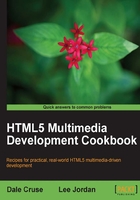
Highlighting text using the mark element
"The
<mark>element represents a run of text in one document marked or highlighted for reference purposes, due to its relevance in another context. When used in a quotation or other block of text referred to from the prose, it indicates a highlight that was not originally present but which has been added to bring the reader's attention to a part of the text that might not have been considered important by the original author when the block was originally written, but which is now under previously unexpected scrutiny. When used in the main prose of a document, it indicates a part of the document that has been highlighted due to its likely relevance to the user's current activity." - WHATWG's HTML5 Draft Standard - http://whatwg.org/html5
Getting ready
When viewing search results, you'll often find the term for which you searched highlighted. Instead of relying on a semantically meaningless tag, we can now use the more meaningful <mark> element.
How to do it...
In this recipe, you'll see HTML5doctor.com has an excellent example of how to use the new <mark> element to highlight a search results term. This gives a useful semantic hook not only for styling but also for the machine tracking the results.
<!DOCTYPE html>
<html lang="en">
<head>
<meta charset="UTF-8">
<title></title>
<!--[if lt IE 9]><script src="http://html5shiv.googlecode.com/svn/trunk/html5.js"> </script>[endif]-->
<meta name="viewport" content="width=device-width, initial-scale=1.0">
</head>
<body>
<h1>716,000,000 search results for the query "<mark>HTML5</mark>"</h1>
<section id="search-results">
<article>
<h2><a href="http://en.wikipedia.org/wiki/HTML_5"> <mark>HTML5</mark> - Wikipedia, the free encyclopedia</a></h2>
<p><mark>HTML5</mark> is the next major revision of <mark>HTML</mark> ("hypertext markup language"), the core markup language of the World Wide Web. The WHATWG started work on the ... <a href="http://en.wikipedia.org/wiki/HTML_5"> Read more</a></p>
</article>
<article>
<h2><a href="http://dev.w3.org/html5/spec/Overview.html"> <mark>HTML5</mark></a></h2>
<p>A vocabulary and associated APIs for <mark>HTML</mark> and XHTML. Editor's Draft 16 August 2009. Latest Published Version: http://w3.org/TR/<mark>html5</mark>/; Latest Editor's ... <a href="http://dev.w3.org/html5/spec/Overview.html"> Read more</a></p>
</article>
</section>
</body>
</html>
Adding a simple style declaration like:
<style type="text/css">
mark {background-color: yellow; font-weight: bold;}
</style>
in the <head> section helps us render this highlighted text:

How it works...
The new <mark> element simply highlights a word or phrase to draw the reader's attention. To do this, simply specify the <mark> to be bold or italicized or highlighted in some way in your corresponding Cascading Style Sheet.
There's more...
Sure, you could mark up and style a search-results page to use the <b> or <i> or even <span> tags to indicate for which term the search took place, but each of those tags only affects the presentation layer. They lack meaning. The new <mark> element can accomplish the same visual effect, while also adding that extra meaning to your markup. In fact, the new <mark> element is full of win.
<Mark> long and prosper
Another great use of the new <mark> element is highlighting a date in a calendar picker, as we often see on any date-based reservation system website like Priceline.com.
Priceline.com highlights the current date by default when booking your itinerary. Instead of using a semantically meaningless tag to achieve this, the new <mark> element could be a perfect candidate to use.

Waiting for browsers
The new <mark> element isn't fully supported by any web browser at the time of this writing. Though the extra semantic meaning may not be apparent to machine readers, we can still use the new <mark> element as a stylistic "hook" until the day its meaning is fully supported by a variety of browsers.
Is "future proof" a word?
Remember that HTML5's new elements attempt to add extra meaning to our markup. The goal is never to take away meaning or break pages. With this in mind, it becomes much more palatable to layer on new elements like the <mark> element that's not fully implemented by browsers yet. Even if its meaning is not fully understood by machines yet, it certainly does not hurt to add it and make our pages as "future proof" as we possibly can.
See also
In 2001, Carrie Bickner prepared the "New York Public Library Online Style Guide" (http://legacy.www.nypl.org/styleguide) for branches of the NYPL to use when updating their websites. In this seminal publication, Bickner made the case for web standards by separating content (markup) from presentation (Cascading Style Sheets) from behavior (JavaScript). The publication was extremely forward-thinking for the time and was in use for many years.